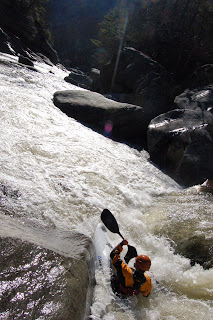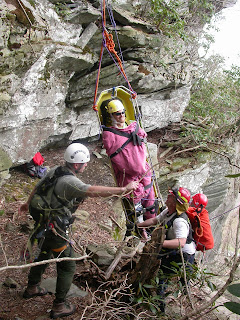





The Gauley sees a lot of traffic and a wide variety of watercraft. Here are a few "floating undercuts" drifting through the flat water. There are so many rafts on the Gauley that it is not uncommon to see them swallowing up kayakers whole only to spit them out further down the rapids. There are other dangers on the Gauley as well. Although it is a place of incredible beauty, every season the river seems to claim at least one life. One weekend, while cruising down one of the river's unnamed rapids, we noticed a pair of distressed kayakers on the left hand shore. I gave a quick glance upstream and noticed a kayaker pinned in a slot between two rocks. I was able to make a quick change of direction and eddy out just below the rock that had him pinned. I slowly and carefully got out of my boat and climbed onto the flat rock where I would be able to access the pinned paddler.

I say slowly and carefully because even though the paddler was in need of help, the rock I was crawling out onto was severely undercut posing a manageable yet significant danger. In a rescue scenario you never want to create a second victim in the process of providing assistance. Dave Clarke was able to safely get up on the rock with me and together we got "hands on" with the pinned kayaker. The best rescue is the most simple one. In this case we quickly attached a rope thrown from the shore to the bow of the boat just as a precaution. I grabbed the paddler by the life jacket and lifted him while Dave lifted the bow of the kayak out of the water. Without making his situation worse we were able to pull him from the slot safely onto the rock. Without rescue he would not have been able to keep his head above water for much longer.

With safety on our minds, and the fall paddling season in full swing, we took a weekend off from kayaking to sharpen our rescue skills. Here the crew practices some common knots used in rope rescue.

The two day, ACA Swiftwater Rescue class run by Sundog Learning covered a variety of rescue techniques from simple to complex. We pushed through some of the season's first cold weather, sharpening our skills and having a great time in the process.

Jump in, the water's great.

Left to right Ted Werrre, Me, Conner Graham, Dennis Gillfilin, Dave Clarke, Will Stubblefield


The next stop on the fall whitewater circuit would be the Russell Fork river. Known as the grand canyon of the south, the Russell Fork releases every weekend in October and offers steeper rapids and smaller crowds than the Gauley. The Russell fork spans the Virginia / Kentucky border and is the home of some of the best people on earth. Each year the folks from Elk Horn City hold a paddler appreciation picnic to celebrate the fall river season and those who come to enjoy it. Here you can find people from all walks of life joining together to share food, spirits and tales from the river. After a few sips from the mason jar it really doesn't matter whether your vehicle of choice is a kayak or a four wheeler.

We were blessed with several first-time runs this season including a stellar birthday run. Here Dave Clarke eats up Tower Rapid for the first (and certainly not last) time.

Below: the author race training in "El Horrendo"

Dennis Gillfilin blowin out the candles of his metaphoric birthday cake
Adam Herzog prepares to disappear
Will Stubblefield pulled over for speeding
Dave Clarke looks down stream toward winter in Costa Rica
As the last few days of 2008 fall off the calender I can't help but to feel blessed. Despite an ugly 2 year drought, we were able to get to the river consistently and each time come home safely. While it's hard to pick a favorite day after having so many good one's, our December run of The Linville Gorge stands somewhat above the rest. Paddling The Linville Gorge reminds of why I kayak. There are few places, especially in the southeast where nature remains so indomitable.
Scouting "Babel Tower"

Alex Hymen gets things started

Kayaking the Linville River takes substantial commitment and effort. Never the less, the rewards are great. The day begins by hiking a mile down into the gorge with your boat and gear. Once you arrive at the river your first task is to run Babel Tower a class V rapid named after the trail that leads from the rim of the gorge down to the river. It's a great rapid, but not much of a warm up. From there the river continues to drop, rarely letting up. The rapids in the gorge call for frequent scouting as wood often collects in hard to see places making many drops unrunable. Unrelenting whitewater, combined with crawling in and out of the boat to scout or portage, begins to take it's toll by the end of the day. Many times I can remember feeling ready for the day to end only to have yet another vertical wall gorge to descend before getting to the takeout. The take out, mind you, is not where the day ends.





Once off the river the Linville paddler must hike a mile and a half long trail that climbs over a thousand feet up to the rim of the gorge. When you finally make it up to the car you arrive humbled. As if the beauty of The Linville Gorge alone were not enough, the experience of paddling there always reminds me of just how small I am in comparison to the forces of nature. In the summer of 2008 two paddlers Chris Gragtmans and Adam Herzog paddled The Linville Gorge 3 times in one day, a landmark accomplishment in anyone's eyes. The high water runs totalled up over 15 miles of whitewater and 7+ miles of hiking...talk about humbling.


What a way to finish off the 2008 paddling season! Many thanks to Will Stubblefield for taking these amazing photographs. Thanks also to everyone involved in getting Sundog up and running this year. The upcoming year already looks to be a busy one. I will spend the winter helping instruct EMT's in Watauga county, then I'll return to the Student Wilderness Medicine Conference for the second year, this time as a presenter. After that we'll be off to Colorado for swiftwater rescue training on Clear Creek. Who knows what else is in store. Here's to a happy and healthy new year, hope to see you down stream!






























